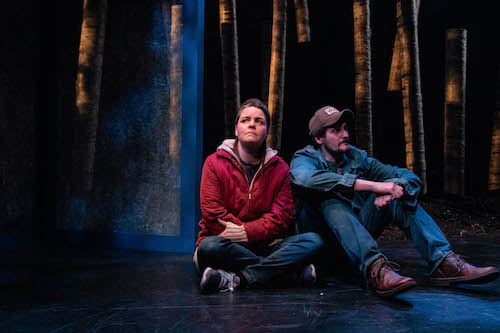
This Is How We Got Here was a finalist for the 2018 Governor General’s Award for English-language drama, and it’s easy to see why; Keith Barker’s meditation on grief is lyrical and haunting. Native Earth Performing Arts’ production gives the script the sensitive treatment it deserves, resulting in an experience that feels both sorrowful and healing.
In the program, each character is not only named but defined in terms of their relationships to each other. This is characteristic of the play’s message, which uses these relationships to help define the characters as well; we are not simply who we are, the script says, but who we are to other people.
We leave pieces of our own stories within others, linking our stories to their own. Here, Craig’s story was cut short by his own hand; the young son of Lucille (Micaela Washburn) and Paul (Kristopher Bowman) took his own life a year ago.
Paul and Lucille’s emotional incompatibility in processing their grief, and their recriminations surrounding the tragedy, have splintered their relationship beyond recognition and perhaps beyond saving. Lucille’s sister Liset (Tamara Podemski) and her husband Jim (James Dallas Smith), Paul’s best friend, attempt to act as a support system, but underestimate the depths of their own pain, often making things worse.
All recall the tale of the fox who told others’ stories so much that he lost his own. Their stories face a reckoning on the anniversary of Craig’s death, when a real fox visits Liset’s garden, cleverly only represented by sound cues (Christopher Stanton) of the mayhem it’s causing.
The set design, by Shannon Lea Doyle, is an open-concept representation of home that blurs the lines between inside and outside, including effective use of fabric “walls” that can be opaque or translucent as necessary to reveal character. It’s backed upstage by a cluster of birch trees repurposed from Tarragon’s production of YAGA (designer Joanna Yu); the copse of trees looks like it should be natural and alive, but each tree is clearly cut off, stumped. It’s a short mental leap from this to seeing the trees as a grove of pale mourners, each standing yet clearcut by loss.
Appropriately for the title, the play opens near its chronological end, and then wends its way back in non-linear fashion, giving us splintered puzzle pieces that help us patch together how the characters got there. It’s a very smart device, turning what could be a familiar story into something that makes us work a little harder.
It juxtaposes past harms and present issues, occasionally bringing out levels of dramatic irony. It also reminds us that grief and recovery are anything but a chronological, linear process with achievable steps, but rather unending in unpredictable ways. “You can’t fix this, so stop trying,” says a character. There are no fixes here, just understanding; even understanding is difficult because everyone grieves differently.
Within this very personal story, there are nods to the surrounding community’s attempts to process the trauma, which brings up themes of conflicts between hardline Christian and traditional Indigenous beliefs, obedience and humanity, and toxic masculinity and vulnerability. The production even uses its land acknowledgement to establish character and pay respect to the enduring power of story.
The script could easily become melodramatic in the hands of less-skilled actors, but the quartet here all effectively portray the mixed emotions involved. Paul’s metaphor-laden speech to a suicide support group is delivered sotto voce by Bowman, but it’s so intense and focused that you can hear every word – and you could hear a pin drop in the silent space, if one were to do so.
It’s a magic moment after watching most scenes end in emotionally-revealing shouting matches, and almost justifies having so many of the scenes follow such a similar emotional arc. If there’s one quibble with the script, it’s that the sheer number of scenes with such an arc gives each one slightly less power.
In a similar vein, though, Washburn’s delivery of Lucille’s monologue about her son, which subverts every social-media-friendly line on parenthood, is remarkable in its matter-of-factness, amplifying the pain in her eyes with every sentence.
While Jim and Liset are supporting characters (literally), they’re both well developed, each subverting an initial characterization (Liset, hard-edged, Jim, goofy and not that bright) to become more than the sum of their parts. A sitcom-like fight that deepens into a candid discussion of panic attacks, and Jim’s revelatory monologue about letting go, make it clear that nobody is unaffected when one story ends.
David Kessler, co-author of On Grief and Grieving, writes: “Each person’s grief is as unique as their fingerprint. But what everyone has in common is that no matter how they grieve, they share a need for their grief to be witnessed.” This Is How We Got Here gets us to the point of witnessing. It gets us “here,” and no further, promising no easy answers or resolutions. It just asks us to sit with it for a while. In return, it gives us ideas that are as clever as a fox, and a story as rich as a garden.
Details
- This Is How We Got Here plays at Native Earth Performing Arts’ Aki Studio at Daniels Spectrum (585 Dundas St. E.) until February 16, 2020.
- Shows run Tuesday-Saturday at 8:00PM, and Sundays at 2:00PM.
- Tickets are $20 – $30 and can be purchased online, by calling 416-531-1402, or at the Theatre Box Office.
- The show runs approximately 75 minutes.
Photo of Michaela Washburn and Kristopher Bowman by Christie Wong
